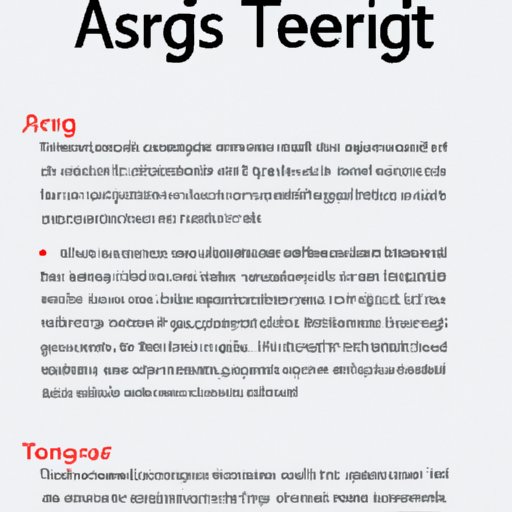Introduction
Argumentative writing is a type of writing that requires students to analyze a topic, collect, generate, and evaluate evidence, and establish a position on the topic in a concise manner. Teaching argumentative writing can be a challenge, especially for students who are unfamiliar with the concept. This article seeks to provide educators with a clear understanding of how to teach argumentative writing, as well as tips and strategies for engaging students in the process.
Outlining the Stages of Writing an Argumentative Essay
The first step in teaching argumentative writing is to explain the stages involved in producing an effective argumentative essay. These stages include choosing a topic, researching both sides of the issue, outlining the essay, writing the introduction, developing the body paragraphs, writing the conclusion, and revising the essay. It is important to emphasize that each stage is essential to the overall success of the essay.
For example, when explaining the stage of choosing a topic, it is important to encourage students to select a topic that is interesting to them and one that they feel passionate about. Additionally, it is useful to provide students with examples of topics that would make for compelling essays, such as gun control, animal testing, or climate change.

Developing a Strong Thesis Statement
A crucial part of argumentative writing is developing a strong thesis statement. A thesis statement is a sentence or two that states the main idea of the essay and captures the author’s position. It should be clear, concise, and arguable. To help students create a strong thesis statement, it is helpful to provide them with a few strategies.
First, it is important for students to understand the purpose of a thesis statement. Explain that a thesis statement is used to state the main point of the essay and to give the reader an overview of what the essay will be about. Additionally, it is important to stress that a thesis statement should be specific and arguable. For example, instead of “Gun control is a controversial issue,” a more specific and arguable thesis statement would be “Stricter gun control laws are necessary to protect citizens from gun violence.”

Researching Both Sides of an Issue
Once students have selected a topic and developed a strong thesis statement, it is important to emphasize the importance of researching both sides of the issue. Explain that in order to effectively argue their point of view, they must first understand the opposing viewpoint. Encourage students to look at both sides of the issue and to consider any counterarguments they may encounter. Additionally, it is important to remind students to use reliable sources when conducting their research.
Structuring an Argumentative Essay
When it comes to structuring an argumentative essay, there are a few key components that should be included. Explain to students that an argumentative essay should include an introduction, body paragraphs, and a conclusion. Additionally, each body paragraph should focus on one main point and provide evidence to support that point. Finally, remind students to use transition words and phrases to help move the essay along.
When writing the introduction, it is important to grab the reader’s attention by using a hook or an intriguing fact. Then, the thesis statement should be stated clearly and concisely. In the body paragraphs, each point should be supported with evidence and explained thoroughly. Finally, in the conclusion, the main points should be summarized and the author’s position restated.
Using Evidence and Counterarguments
In an argumentative essay, it is important to use evidence to support the claims being made. Explain to students that it is not enough to simply state their opinion; rather, they must back up their opinion with facts and figures. Additionally, it is important to discuss the use of counterarguments. Remind students to consider any potential opposing arguments and to address them in their essays.
Explain that counterarguments are an important part of an argumentative essay because they demonstrate the writer’s ability to think critically and to anticipate what others may say in response to their position. Additionally, by addressing counterarguments, the author can strengthen their own argument by demonstrating that they have considered all aspects of the issue.
Conclusion
In conclusion, teaching argumentative writing can be a challenging process. However, by following the steps outlined in this article—explaining the stages of writing an argumentative essay, developing a strong thesis statement, researching both sides of an issue, structuring an argumentative essay, and using evidence and counterarguments—educators can provide students with the necessary tools to craft compelling and persuasive arguments.
(Note: Is this article not meeting your expectations? Do you have knowledge or insights to share? Unlock new opportunities and expand your reach by joining our authors team. Click Registration to join us and share your expertise with our readers.)
